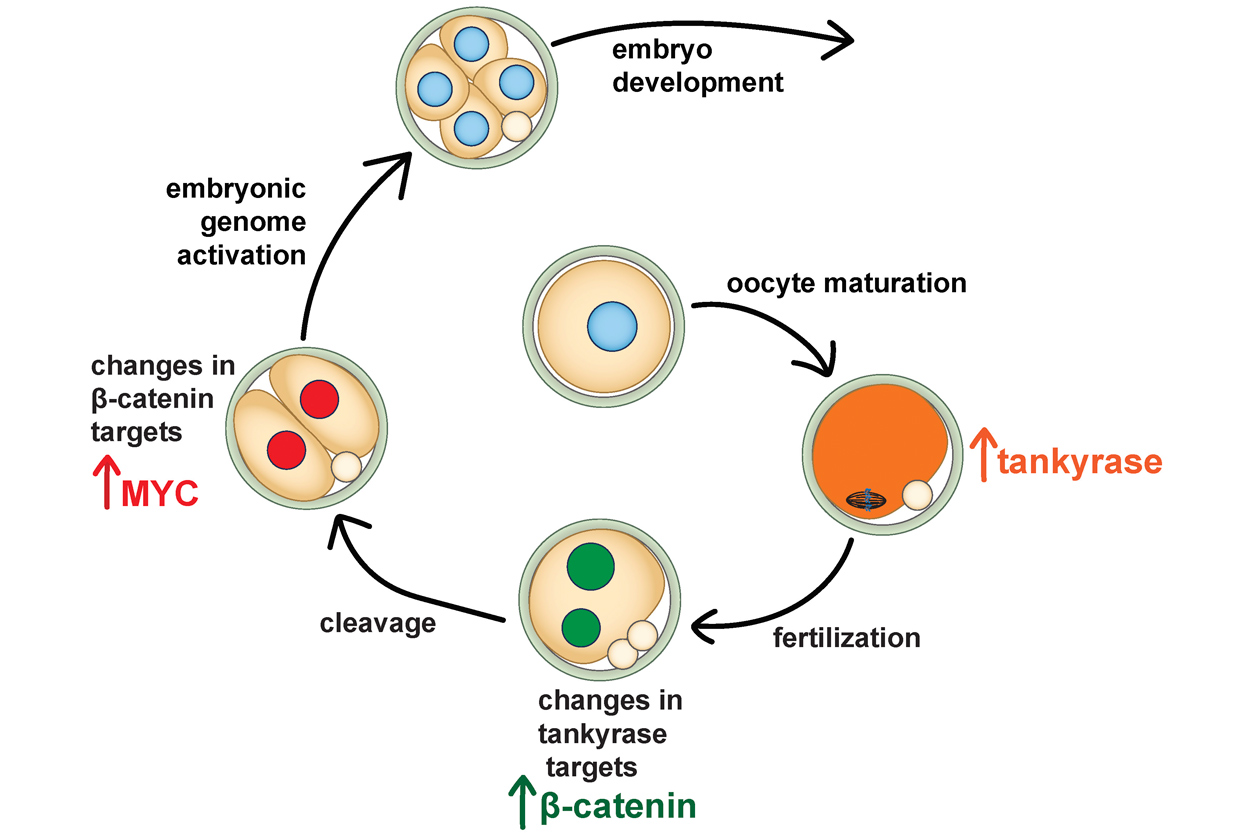New findings on a molecule required for the normal development of fertilized eggs could lead to improved procedures in assisted reproductive technologies (ARTs) used to treat infertility. NIEHS researchers showed that this molecule, called tankyrase, is required for embryos to make new proteins through a process called embryonic genome activation (EGA). The study was published online May 21 in Developmental Cell.
 Williams’s group addresses the mission of NIEHS by carrying out basic research to promote understanding of the effects of the environment on human reproductive health. (Photo courtesy of Steve McCaw)
Williams’s group addresses the mission of NIEHS by carrying out basic research to promote understanding of the effects of the environment on human reproductive health. (Photo courtesy of Steve McCaw)“Fertilization and EGA occur in a Petri dish during ART,” said senior study author Carmen Williams, M.D., Ph.D., deputy chief of the Reproductive and Developmental Biology Laboratory (RDBL) at NIEHS. “Although the effectiveness of these procedures has improved over the years, failure of EGA is one of the causes of arrest in development or early miscarriages. Basic knowledge about the mechanisms that govern fertilization and EGA is key to improving these technologies.”
Concerns about conception
Infertility is defined as not being able to achieve pregnancy after one year of having regular, unprotected intercourse or after six months if the woman is older than 35 years of age. It can be attributed to the woman in one-third of couples, to the man in another one-third of couples, and to unknown causes or both the man and woman in the remaining one-third.
The condition is common. Approximately 6% of married women aged 15 to 44 years in the United States are unable to get pregnant after one year of trying (see sidebar). To treat this problem, it is necessary to understand the molecules that guide normal embryonic development, Williams explained.
How embryos make new proteins
Past research has shown that fertilization — the fusion of sperm and egg to create the embryo — triggers embryonic genome activation. This process provides instructions to embryos on how to make new proteins. But it has not been clear how specific molecules orchestrate that activation, according to co-first author Paula Stein, Ph.D., a biologist in RDBL.
 In recent years, Stein has studied the role of calcium signaling in the development of mammalian embryos. (Photo courtesy of Steve McCaw)
In recent years, Stein has studied the role of calcium signaling in the development of mammalian embryos. (Photo courtesy of Steve McCaw)“We are interested in understanding how life begins, specifically, what mechanisms are responsible for creating an individual from the union of sperm and egg,” Stein said. “This knowledge is essential to learning how environmental factors affect our ability to reproduce and have healthy offspring.”
Arrested development
In the new study, the researchers used a mouse model that closely mimicked fertilization and embryo development in humans. In the absence of tankyrase, the mouse embryos could not successfully carry out genome activation. As a result, the embryos stopped developing soon after fertilization.
“Healthy conditions for egg cell maturation are important for the egg to properly generate proteins like tankyrase and promote success of embryo development,” Williams said.
 Tankyrase, made during oocyte (egg cell) maturation, causes the beta-catenin protein to go to the nucleus of the one-cell embryo. The protein causes two-cell embryos to make MYC protein, which drives synthesis of new proteins that support EGA and embryo development. (Image courtesy of Carmen Williams)
Tankyrase, made during oocyte (egg cell) maturation, causes the beta-catenin protein to go to the nucleus of the one-cell embryo. The protein causes two-cell embryos to make MYC protein, which drives synthesis of new proteins that support EGA and embryo development. (Image courtesy of Carmen Williams)Understanding human infertility
Previous research showed that tankyrase regulates several cellular pathways that are disrupted in cancer, according to Williams. For that reason, tankyrase inhibitors can be used in combination with chemotherapy. But the purpose of the molecule in early embryo development was unknown before the new study, she explained.
Going forward, Williams and her team will further explore the role of proteins in the maturing egg, along with sperm-derived signals, in early embryonic development. “Information gathered in these studies will provide a better understanding of factors causing human infertility, which affects approximately 10% of the reproductive age population,” she said.
Citation: Gambini A, Stein P, Savy V, Grow EJ, Papas BN, Zhang Y, Kenan AC, Padilla-Banks E, Cairns BR, Williams CJ. 2020. Developmentally programmed tankyrase activity upregulates beta-catenin and licenses progression of embryonic genome activation. Dev Cell; doi.org/10.1016/j.devcel.2020.04.018 [Online 21 May 2020].
(Janelle Weaver, Ph.D., is a contract writer for the NIEHS Office of Communications and Public Liaison.)









